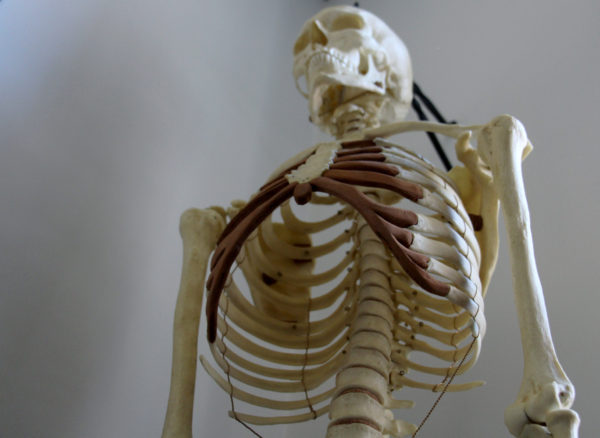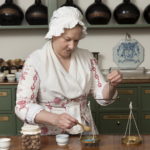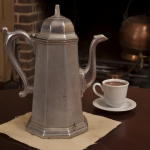
Peek into the back room of the Pasteur and Galt’s Apothecary and you’ll find its most standoffish resident. Which is understandable, because while he may be articulated, he can’t talk, seeing as he’s a skeleton. But this is no ordinary bag of bones.
In fact, this may be the most authentic, possibly only, reproduction 18th-century articulated skeleton (bones reassembled to function as in life) in existence. And it wasn’t easy. The project of creating it required the combined expertise of colleagues across the foundation, as well as evidence from archaeology, history, and bioarchaeology.
Any skeleton is pretty cool up close. I remember one a foot tall or so that I had when I was a kid, which was fun to fool around with. I may have even learned something. Either way, our skeleton serves a similar purpose in the Apothecary, showing how, in the age of Enlightenment, people used more than books to learn about anatomy.
The use of articulated skeletons dates back to at least 1543, when Brussels-born Andreas Vesalius advocated for their usefulness in his magisterial work on anatomy, De Humani Corporis Fabrica Libri Septe (“On the Fabric of the Human Body”).
Courtesy of Wellcome Library, London
By the 18th century there were purveyors of articulated skeletons, such as Nathaniel Longbottom, whose business card offered services that included assembling “loose sets of bones” and even shipping his products by land or sea.
A couple of fragments from articulated skeletons have been found in Williamsburg’s Historic Area. In the 1960s a mandible was unearthed behind apothecary George Gilmer’s 18th-century residence. While the bone showed some significant wear and damage, it had a hole suggesting that it had been assembled with other pieces of a skeleton.
In the 1990s a dig preceding the reconstruction of Charlton’s Coffeehouse turned up an intermediate phalanx, that is, the middle of a finger, with two pieces of copper wire coming out of the bone, and a slit in the end (see photos above). An x-ray yielded evidence of where a plate would have been.
We also know that Williamsburg doctor Kenneth McKenzie left a “skeleton and injected child” to Dr. James Carter in his will. So it’s reasonable to speculate that one or more articulated skeletons may have been present in Williamsburg: as a tool for teaching or learning, or even just as a conspicuous status symbol for a properly educated practitioner of the art of medicine.
In Pasteur and Galt’s Apothecary near the Capitol, the ingredients for a variety of cures and treatments sit on the shelves. Dr. Galt’s medical certificate hangs on the wall near a table with bandages and surgical instruments. But the skeleton helps to complete the picture, showing how medicine was actively being investigated.
Amanda Keller, Associate Curator of Historic Interiors, wanted to figure out if it was possible to get a period-appropriate skeleton for the Apothecary. 18th-century articulated skeletons are true rarities, and in any case our policy on the display of human remains prohibited using a real skeleton. Modern models are assembled quite differently. How could we, she wondered, somehow reconstruct an authentic-looking version?
Amanda’s investigation led to Ellen Chapman (above, with glasses), a talented doctoral student in the College of William and Mary’s Anthropology program who had been researching human remains and 18th-century articulation techniques as an intern for Joanne Bowen, our Senior Curator of Environmental Archaeology. The task of faithfully assembling the skeleton would fall to Ellen, with the assistance of our toolmaker and tradespeople.
In addition to the archaeological evidence and her own expertise, Ellen depended heavily on a key written resource, a 1790 tract by Thomas Pole titled The Anatomical Instructor. Pole was a member of the corporation of surgeons in London; his was the first English-language guide detailing how to take a cadaver and successfully deflesh, degrease, and articulate a skeleton.
Using Pole’s work as a starting point, Ellen worked out a tentative assembly plan using a cheap plastic skeleton. She wanted to figure out where to drill holes, run wire, support weight, and articulate plates in the bones. Not that he spelled out every detail.
By happy coincidence, Robin Kipps and Sharon Cotner from the Apothecary happened to attend a conference at the Royal College of Surgeons and were able to interview their head curator and examine articulated skeletons in the Hunterian Museum collections there. They needed to better understand precisely how hinges and wires were used to hold the skeleton together in that period.
An unassembled skeleton was ordered. The bones are actually plastic composite cast from a human skeleton, a 34-year old man of European descent, 5-foot-8 and 185 pounds, who died of multiple gunshot wounds, although the skeleton was not damaged by the fatal wounds.
Working behind the scenes with various colleagues, Ellen began the exacting task of putting the human puzzle together.
“I think the most frustrating part of Pole’s description was for the hands and feet,” said Ellen. His instructions said to put wire through the hands and feet “in any direction, so as to confine them in their natural relative situation.” But what was the most secure and accurate way of doing that?
She ended up basing them on the modern anatomical specimens in Joanne Bowen’s lab, using a very slender bit to drill holes longways through the bones of the hands and feet and weaving brass wire through to hold them in place.
Our toolmaker was able to custom-manufacture various connectors, including 18th-century nuts for the mandible, pelvis, knee, and the top of the skull. She modified a knife so brass plates could be fit in at the joints of bones to insert brass plates. Senior Curator Erik Goldstein advised the team on what metal alloys would have typically been used at that time.
The rib cage was a particular challenge. While they had a version of cartilage made of the plastic resin, Robin and Sharon had reported that wire glued between pieces of leather leather was used to keep the rib cage cartilage steady in the 18th-century articulated skeletons they examined.
Cow leather from the artificer’s shop was filed down to the right size and fit. Wire was run through the center of the leather so it could be properly shaped. Brass pins held everything in place. You can just make out the marks in the pictures.
“It was a very three-dimensional project because the seven-to-ten ribs all connect to the same piece,” said Ellen.
Another difficulty came in trying to get the S-curve of the spine just right, which took several tries. A metal rod kept the vertebrae in place, but when it looked a little too stiff, they used period drawings to finesse it. The discs in the spine were also constructed with cork.
We could have ordered a reasonably plausible modern skeleton and no one would have been the wiser. Instead, a diverse team of curious and talented colleagues embarked on a voyage of rediscovery that contributed to our knowledge of the 18th-century world.
Ellen expects the skeleton to have a long life in the Apothecary, where it will round out the shop’s interpretation of 18th-century medicine. For her part, Sharon doesn’t think people were as creeped out by skeletons as they are today. And what’s there to be spooked by? After all, she says, “you’re carrying one around with you right now.”
Thanks so much to Ellen Chapman for sharing her photos of the assembly process!


Andi Boyles says
What is an injected child?
A hard thing to contemplate. The bodies of infants and fetuses were desired for some types of anatomical study and teaching purposes. They may be injected with a colored wax to bring out certain features such as aspects of the circulatory system. In some ways this is similar to displays of human skeletons that are real. A question of where the needs of science comes up against our sense of morality, ethics, and a desire to bring a sense of dignity to the remains of deceased humans.
Even today there has been a roving tour of human bodies, usually making its way to things like “science” centers. The preparers stripped off layers of skin to reveal muscles and other internal organs and by some technique “plasticized” them in various natural poses. I could not bring myself to go to one of those myself but have seen pictures. They look like an illustration from an anatomy textbook, only they are real bodies.
In the modern cases, at least, resin is injected into the circulatory system. I can’t say whether resins were used for such things, back then, because I don’t know the properties of any curing agents of the oeriod.
Fascinating: after seeing a badly-prepped “murder victim” skeleton in a cop show, as a child, (they didn’t even try to hide the brass latch on the side of the skull) I bacame fascinated with the stories skeketons tell, and with the idea of making fake ones more realistic, for film. When I worked in a Hollywood Prophoise, I developed a finish paintingbtechnique to make tesin bone look real. I have reason to believe the skuls in the treasure piles on thr first Pirates of the Caribbean movie were ones I’d done, but YOUR project is a true work of art! I’m rather envious!
That last comment was supposed to go in the main thread. Sorry!
Bill, very interesting and informative article. Thanks for your excellent writing and kudos to all the talented specialists and historians involved.
I second the opinion of Dorothy: let’s add this one to a tour/lecture. A true ” skeleton in-the-closet ” learning experience. Fascinating, and educational.
I think this is a good reason to have this blog. Reading stories like this, and there are so many, reminds me that virtually everything I see when I visit has a significant story behind it. I imagine it is easy for a casual visitor to spend the day walking around, especially those who do not think it worthwhile to buy a pass, and see the literally thousands of objects and the hundreds of buildings, and the clothing, and have little to no appreciation for the research and skills and work that made each possible. I try to spend seven to fifteen days in the historic area, and would do more if time and family things permitted. I am a pretty strong devotee of CW considering I live a four hour drive away. Anyway I have come to learn that I will never come close to learning about everything I see and experience there. On top of it, new things like this are added as fast as I can pick up on the old ones anyway!
I appreciate that it is an ongoing effort. Makes me want to keep up my commitment as well.
Thank you, Jeff! I hope other will see it just as you do, and many thanks for your continued support!
This explanation and display would make a great tour or lecture in itself. Don’t combine the pottery excavation and other tours at the Lab. with this one.
Very interesting.
See you there at the tour!
Indeed! There are stories to be found wherever you think to ask a question!